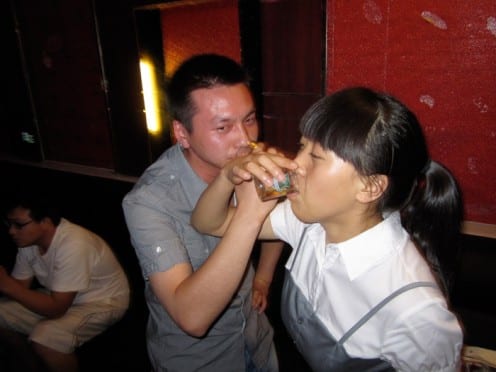
Social drinking in a chinese karaoke (Photo: Tom McDonald)
It is 11:42 on a Tuesday night, in the height of Red Mountain Town summer, and I find myself standing in a darkened, noisy and stifling, private room four by ten feet in size. Running along one side of the room is a fitted sofa covered in vinyl padding that is supposed to imitate leather, and opposite it a flat screen television. In the space in between is a table, holding a semi-decimated feast of beer bottles, fruit platters, sesame seeds, and cigarette packets. In the corners of the room, above the television, hang two oversized speakers, blaring out distorted music. The room is walled with a smooth glittery surface, constructed from opaque, black-silvery backed tempered glass, set into which are metal purple and red fluorescent lights, and plain strips of metal detailing.
There are seven people in the room, mostly tubby men and women in their forties or fifties; respectable businessmen, engineers, nurses, and retired townsfolk. Their faces are entirely smeared in birthday cake, a bizarre combination of clotted cream, and light fluffy primrose-yellow sponge, as if they were characters straight out of a ‘Laurel and Hardy’ custard-pie fight gone awry. They are maladroitly dancing to the corrosive 2005 Euro-trance song ‘Axel F‘ by Crazy Frog, in an almost paraplegic conjunction of un-coordinated hand waving, and leg shuffling, whilst on the television, askew decade-old video footage shows young nubile bikini-clad Chinese women writhing, out of time with the music, on the stage of an anonymous crowd-filled nightclub in an unidentified Chinese city. In front of me, one portly woman, a divorcee, grabs her boyfriend, a scrawny forty year old moustachioed ferret-like man, and they break into a mini-waltz, which they manage to sustain for about thirty seconds before reverting to their discombobulated convulsive gyrations. One man breaks off from his bopping to stand by the light switch, eagerly turning it on and off repeatedly, plunging the room in and out of darkness in a disordered strobe effect.
A corpulent fellow, heavily exuding sweat, grabs me, throws his arm around my shoulder while thrusting a bottle of Kingway beer into my hand, “Bottoms up!” he bellows into my ear over the music, knocks back his head, and with concentrative purpose, glugs down the beer as if he were a baby suckling fervently on his mother’s teat. I do not want him to feel I am spurning his generosity, so I follow immediately, despite having long before lost track of how much I have had to drink tonight. The warm, additive-soaked beer gushes past my pharynx, and down my throat, as I put in a concerted deglutitive effort. I am out of practice, though, and find simultaneously breathing through my nose, while swallowing the drink and maintaining eye contact with the heavily perspiring man unexpectedly problematic. When I reach the point of asphyxiation I involuntarily gag, foamy carbonated beer erupts from my mouth and down my neck. No sooner than I have drawn the bottle away from my face, though, that another man, who I am unaware is standing behind me claws a handful of cake into his palm, and swings it towards my face, as if applying a chloroform-soaked towel to an unsuspecting kidnap victim, roughly smearing the syrupy mixture over my face, and ears, and most of my clothes.
I take a moment to remind myself where I am. ‘Heaven on Earth Karaoke parlour’ in Red Mountain Town. I wonder for a moment how on earth did it come to be, that out of all the places in the world, I should have ended up here? Then another, altogether more interesting question popped into my head: how on earth did it come to be, that ‘Heaven on Earth Karaoke parlour’ should have ended up to be like this?
The above fieldnotes were made as part of my PhD research into the structures of hospitality in a medium sized town in south-west China. The thesis examines the way in which everyday hosting activities, such those described in the karaoke parlour above, become significant by their adoption of certain material and behavioural structures of hospitality that are partly homologous to forms of hosting in popular religious life and traditional ways of receiving visitors into the home.
Central to many forms of hosting in Chinese society, especially between adult males, are alcohol (Chau, 2008:493) and cigarettes (Wank, 2000). My own friends in Red Mountain Town would often wax lyrical about what they perceived to be the country’s ‘alcohol culture’ (jiu wenhua 酒文化). This concern with using alcohol to comfort others extends to the afterlife: during the tomb sweeping festival my friends would leave a cup of liquor on their ancestors’ tombs for their deceased relatives to consume.
I, on the other hand, did not always see their hospitality in a wholly favourable light, doubtless because my own attitudes have been shaped by the far less positive national discourse surrounding alcohol and smoking that exist here in Britain. However, China too is starting to become aware of the problems that these specific forms of sociality bring. Commercial alcohol production in the country has increased from 0.4 kg beverage alcohol per person in 1952, to an estimated 42.5 kg per person by 2005 (Cochrane et al., 2003). Rates of diabetes and lung cancer in China are increasing at amongst the fastest speeds in the world, and I witnessed first hand the distress, heartbreak and loss that these diseases bought to families in the town.
Nevertheless, this problem seems to be a social one. Alcohol and cigarettes appear to be inseparable from the creation of friendships in China. Which is why social networking is of particular interest. On QQ, China’s most popular social networking service, it is possible to give one’s friends ‘virtual’ gifts of alcohol and cigarette lighters (amongst other things).

Gifting french red wine on QQ (Image © QQ)
This raises a question of whether China’s youth are increasingly tiring of some of the social behaviours of older generations. Are options to gift virtual versions of such objects ways in which they are seeking new forms of sociality, at once different from other generations, whilst still remaining identifiable with ‘traditional’ Chinese culture?
Of course, it is impossible to tell from this one piece of evidence, but given that our study of social networking will have an important welfare element, I hope that through the ethnographic encounter I will be able to find out in what ways social networking might be influencing these established means of relating to each other.
References
Chau, A. Y. (2008). The Sensorial Production of the Social. Ethnos, 73(4), 485-504.
Cochrane, J., Chen, H., Conigrave, K. M., & Hao, W. (2003). Alcohol use in China. Alcohol and Alcoholism, 38(6), 537-542.
Wank, D. L. (2000). Cigarettes and Domination in Chinese Business Networks: Institutional Change during the Market Transition. In D. S. Davis (Ed.), The consumer revolution in urban China (pp. 268-286). Berkeley; London: University of California Press.
Filed under Comparison, Culture, Low income, Parenting
Tags: alcohol, alcoholism, anthropology, baijiu, China, cigarettes, diabetes, drinking, ethnography, exchange, fieldnotes, fieldwork, French, Friends, friendship, gifting, health, karaoke, lung cancer, medicine, QQ, red, religion, singing, smoking, social networking, wellbeing, wine
Comments Off on Cigarettes and alcohol: towards healthier relationships through social networking?
 Close
Close












